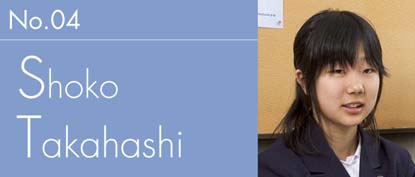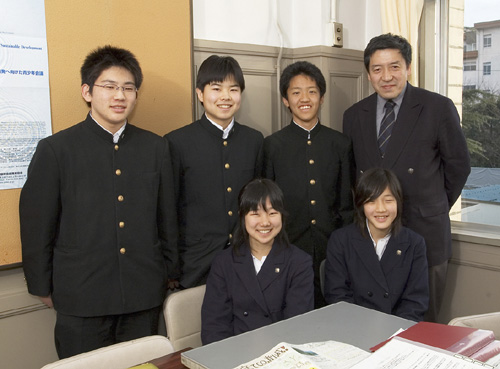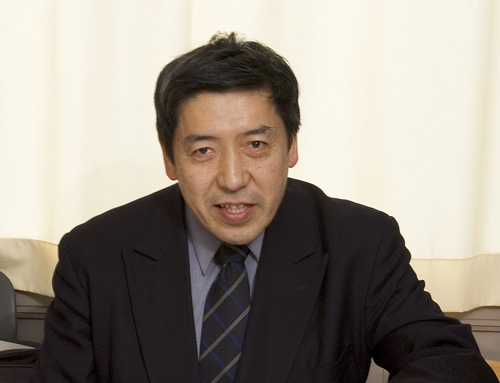Environmental Activity Interviews

Name
Shoko Takahashi
-Deforestation was her first interest in the environment
Shoko had never given any thoughts to the environment while she was living in the United States. It was in fifth grade, when she returned to her native Japan, that she started to think about it. The scene of her new home, standing on a mountain slope where the trees were cut down, struck a chord with her. New homes continued to be built around her house while she felt that the forest seen from her balcony was somehow shrinking in size. She was thinking to herself that this was wrong and something had to be done. While unable to take any action, she eventually entered junior high school.
-The encounter with Blue Earth Summit – a strong feeling for the environment built up
Shoko learned of Blue Earth Summit, a group actively pressing forward with environmental activities. It was a special off campus committee made up of junior high school students in Yokohama City. On campus, the members are involved in energy conservation activities such as making sure to turn off unused lights in classrooms. Off campus, they volunteer to pick up trash, hold observation meetings of nature, and hold discussion sessions at JUNEC. With the help of their alumni, Blue Earth Summit is working to deepen people's understanding of the nature across generational lines. Shoko, already interested in the environment and strongly recommended by her teacher, decided to join the committee. "I was interested in deforestation since elementary school, but it was such a huge issue to take action against on my own. Through activities at Blue Earth Summit, I contemplated what I could do right away to help, and came to the conclusion it was to work on energy conservation," said Shoko. She became engrossed in the activities at Blue Earth Summit, and eventually grew into one of the main members.
-Energy conservation was at the core of the "Environmental Project"
From the ten options for the integrated studies period, Shoko selected the Environmental Project. Students on this project do research on their own on a selected topic. The teams consist of students from different grades and they take part in meetings to exchange opinions with people outside of the school, as well as give presentations (report their findings to the citizens in the area) six times annually. Her school had been identified as a model school promoting energy conservation before she enrolled, and they were newly identified as a model school promoting education of energy environment in her third year junior high school. The theme selected for the project, consequently, was the environment. Shoko and some other project members started research on energy conservation, a topic she had been interested in for a while. They did research on the internet and at the library, and they also visited Tokyo Electric Power Company to conduct an interview. Their research focused on energy conservation activities, which are efficient and easy for all to take part in.
-Participation at the Summit broadened the circle of participants in activities
Shoko was an active participant at Blue Earth Summit as well as in the Environment Project. It was around this time she was informed of the Children's World Summit for the Environment. With her school backing her she sent in her application. With her avid involvement in environmental activities, she was not only accepted to join the Summit but was also selected to be on the Junior Board. Yamashita, Takido, Hatake, and Tachikawa were fellow participants at the Summit from her school. Shoko's life suddenly became busy. During the Summit, there were some nights she could only get three hours of sleep. As the pen pusher for the Chat Meetings, she took down everything on two computer screens or more, while stuffing some late-night snack in her mouth. "I was extremely busy but it was still very enjoyable because what I was doing was worth the while," says Shoko with a contented smile.
-Participants from all over the world broadened their view on the environment
At the Summit Shoko spoke out her thoughts on energy conservation and felt she had struck a chord quite strong. She was determined to exploit her position as the Junior Board member, speaking to many people and striving to learn of their ideas. The scale of activities done by others especially impressed her. Some had gotten their whole family involved while some others were working on a national level with their country's president involved. Shoko's knowledge and view on the environment was positively affected through her meeting with these new friends. She says she felt she was blessed with a great opportunity. "By meeting people from all over the world, I felt how limited my efforts were. I was inspired to work much harder," said Shoko with blazing enthusiasm.
-Disseminating what she learned about the environment
She came across a new theme at the Summit, recycling. "At the EXPO 2005 AICHI, JAPAN I was impressed by the array of waste boxes for different types of trash. Upon realizing the neatness of the recycling system already in place in Japan, I decided to keep it on my mind at all times," said Shoko. When we asked her about her future activities, she told us the following. "The awareness toward the environment in general still seems too low. I feel the need to share with others what I have learned and hope that the younger students at my school will strive to do just that." Shoko will continue to be a member of Blue Earth Summit as an alumna. Although the high school she will enter in spring is not very active in environmental activities, she is determined to deepen the understanding toward the environment among the students there.
-An Interview with Shoko Takahashi's homeroom teacher, Mr. Kiyoshi Honda * She was a natural leader with a strong awareness
"She was a natural leader," says Mr. Honda. This was obvious during the Environmental Project in which she excelled in the activities. He added, "Since she was gifted with the ability to lead others, there were expectations among others that she would be able to bring the group together." Mr. Honda says since she had a strong awareness toward the environment, he felt she will be able to pull off something big. But he feels taking part in such a huge event and interacting with children from all over the globe must have played a large part in broadening her horizon. It seems Shoko, with her natural ability to lead and excel, was meant to be at the Summit.
-To learn on there own is the most important – teachers must only be supporters
We asked Mr. Honda what his role is in the Environmental Project. "The greatest aspect of these projects is that children can work thing out on their own. Therefore I do my very best to work behind the scenes. However, there are times children need to be directed well. Checking each group's progress carefully, I give little advice at those times." Maintaining a cautious distance from the students may be the key to bringing out the best and helping them grow.
-He wishes children grow up to be adults with the same awareness toward the environment
Mr. Honda concedes that perhaps children are more strongly aware of the environment than adults are. "I would like children to carry on that awareness into their adulthood. The children at my school, Shoko a good example, have a strong willingness to share their findings with others. If such an attitude is adopted by the whole society, the future of our earth could only be bright. There is a lot of work to be done. I hope activities toward the environment, without stressing its grandness too much, spread in a positive way," concluded Mr. Honda.

Her fellow participants of the Summit and her homeroom teacher.
From left to right: Takido, Yamashita, Hatake, and Mr. Honda .
In front, from left: Shoko and Tatekawa.







